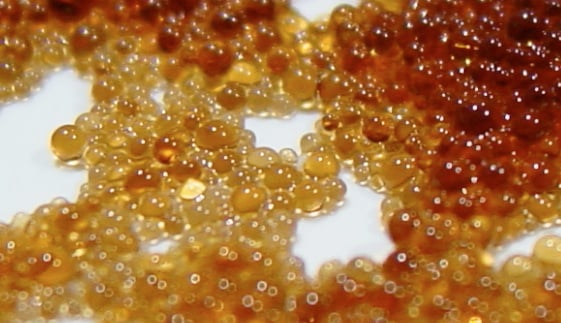ION EXCHANGE
WHAT IS ION EXCHANGE?
Ion exchange is the exchange of ions between two electrolytes, or between an electrolyte solution and a complex. In most cases the term is used to denote the processes of purification, separation, and decontamination of aqueous and other ion-containing solutions with solid polymeric or mineralic ‘ion exchangers’.
Typical ion exchangers are ion exchange resins (functionalized porous or gel polymer), zeolites, montmorillonite, clay, and soil humus. There are either cation exchangers that exchange positively charged ions (cations); anion exchangers that exchange negatively charged ions (anions); and amphoteric exchangers that are able to exchange both cations and anions simultaneously. However, the simultaneous exchange of cations and anions can be more efficiently performed in mixed beds that contain a mixture of anion and cation exchange resins, or passing the treated solution through several different ion exchange materials.
The process can be unselective or have binding preferences for certain ions or classes of ions, depending on their chemical structure. The structure specifically being the size of the ions, their charge, or their structure. Typical examples of ions that can bind to ion exchangers are:
- H+ (proton) and OH- (hydroxide)
- Single charged monoatomic ions like Na+, K+, or Cl-
- Double charged monoatomic ions like Ca2+ or Mg2+
- Polyatomic inorganic ions like SO42- or PO43-
- Organic bases, usually molecules containing the amino functional group -NR2H+
- Organic acids, often molecules containing -COO- (carboxylic acid) functional groups
- Biomolecules which can be ionized: amino acids, peptides, proteins, etc.
- Ion exchange is a reversible process and the ion exchanger can be regenerated or loaded with desirable ions by washing with an excess of these ions.

WHERE IT IS USED?
It is widely used in the food & beverage, hydrometallurgical, metals finishing, chemical & petrochemical, pharmaceutical, sugar & sweeteners, ground & potable water, nuclear, softening & industrial water, semiconductor, power, and a host of other industries.
Most typical example of application is preparation of high purity water for power engineering, electronic and nuclear industries; i.e. polymeric or mineralic insoluble ion exchangers are widely used for water softening, water purification, water decontamination, etc.
Pre-treatment for Reverse Osmosis
It can be used to remove hardness from water by exchanging calcium and magnesium ions for hydrogen and chlorine ions in an ion exchange column. Hardness is one of the main causes for membrane fouling so it’s common to use softeners (ion exchange resins) to extend membranes life.
Residential
It is used in the household (laundry detergents and water filters) to produce soft water, this is accomplished by exchanging calcium Ca2+ and magnesium Mg2+ cations against Na+ or H+ cations (see water softening).
Industrial
Industrial and analytical ion exchange chromatography is another area to be mentioned. This chromatography is a chromatographical method that is widely used for chemical analysis and separation of ions. For example, in biochemistry it is widely used to separate charged molecules such as proteins. An important area of the application is extraction and purification of biologically produced substances such as proteins and amino acids (e.g. DNA and RNA).
Ion-exchange processes are used to separate and purify metals, including separating uranium from plutonium and other actinides, including thorium, and lanthanum,neodymium, ytterbium, samarium, lutetium, from each other and the other lanthanides. There are two series of rare earth metals, the lanthanides and the actinides, both of which families all have very similar chemical and physical properties. Ion-exchange used to be the only practical way to separate them in large quantities, until the advent of solvent extraction techniques which can be scaled up enormously.
Nuclear
A very important case is the PUREX process (plutonium-uranium extraction process). This is used to separate the plutonium and the uranium from the spent fuel products from a nuclear reactor, and to be able to dispose of the waste products. Then, the plutonium and uranium are available for making nuclear-energy materials, such as new reactor fuel and nuclear weapons.
The ion-exchange process is also used to separate other sets of very similar chemical elements, such as zirconium and hafnium, which incidentally is also very important for the nuclear industry. Zirconium is practically transparent to free neutrons, used in building reactors. In contrast, hafnium is a very strong absorber of neutrons, used in reactor control rods.
For nuclear reprocessing and the treatment of radioactive waste, Ion exchangers are used.
Ion exchange resins in the form of thin membranes are used in chloralkali process, fuel cells and vanadium redox batteries.
Understanding Ion Exchange
How Ion Exchange Works
Cation Exchange Resins
- Contain negatively charged functional groups
- Attract and hold positively charged ions (Ca²⁺, Mg²⁺, Na⁺)
- Common in water softening applications
Anion Exchange Resins
- Contain positively charged functional groups
- Attract and hold negatively charged ions (Cl⁻, SO₄²⁻, NO₃⁻)
- Used in water purification and nitrate removal
Applications of Ion Exchange
Water Softening
Water Purification
- Heavy metals
- Nitrates
- Harmful anions and cations
Metal Recovery
- Gold
- Silver
- Platinum
Pharmaceutical Industry
- Antibiotics
- Vitamins
- Specialty medications
Food & Beverage
- Demineralization of whey
- Sugar purification
- Flavor/taste stabilization in beverages
Nuclear Industry
Advantages of Ion Exchange Systems
Selectivity & Customization
Environmentally Friendly
- Reduces use of harsh chemicals
- Minimizes waste
- Often integrated with other sustainable technologies
Challenges and Maintenance
Resin Fouling
Innovations & Hybrid Systems
Technological Advancements
- Higher ion capacity
- Improved resistance to fouling
- Enhanced ion selectivity
Hybrid Treatment Systems
- Membrane filtration
- Adsorption
Sustainable Trends
- Biodegradable resin development
- Use of renewable raw materials
- Energy-efficient system designs
Real-World Use Cases
- Municipal water treatment: Reliable, cost-effective clean water supply
- Mining & metal plating: Reclaims valuable metals, reduces waste
